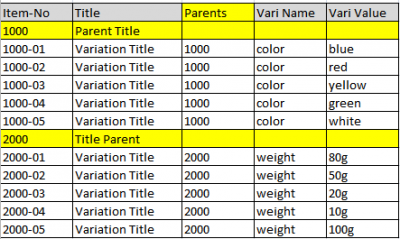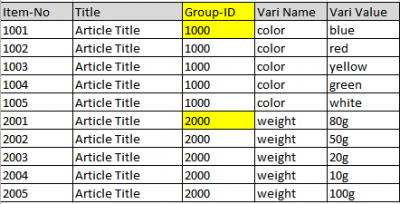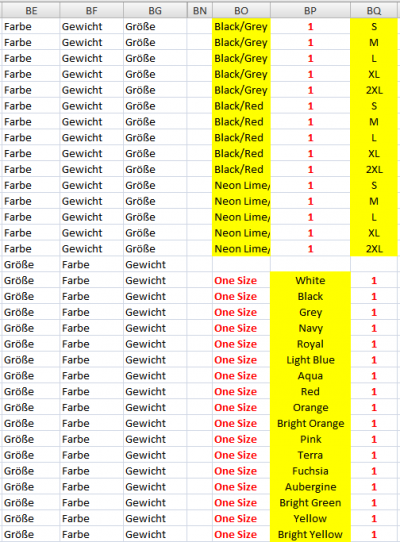Produkte Varianten/en: Unterschied zwischen den Versionen
Haemel (Diskussion | Beiträge) |
Haemel (Diskussion | Beiträge) |
||
| Zeile 25: | Zeile 25: | ||
=== Example 2 === | === Example 2 === | ||
| − | + | Import file with parents as separate data records: | |
Parent items can also be created automatically in the Data Pool using the import function. For this to work, parent records must be present in the import file. The SKU and description of these parent items should (if possible) distinguish them from the variants. | Parent items can also be created automatically in the Data Pool using the import function. For this to work, parent records must be present in the import file. The SKU and description of these parent items should (if possible) distinguish them from the variants. | ||
Version vom 30. März 2016, 15:40 Uhr
Variants can be, for example, necklaces in different lengths (cm): 1010-42, 1010-45, 1010-50 or T-shirts in different colors: 1020-red, 1020-blue and 1020-green. There are several ways to map variant products in the system. Which way you prefer depends on the structure of your records, on your procedure or even on the platform to which your data shall be transferred.
Inhaltsverzeichnis
Search
Search Term - Enter a keyword or product ID.
Parents
Parents can be saved as separate data records in a Data Pool: [ Create new Parent ]. You can then assign any products as a variants to this parent. Once created, you can delete these parents also at any time. By the way; only the parent data record, but not the individual products will be deleted.
Example 1
Parent as separate data record:
- Parent-ID: P12345
- Variants: 12345-white, 12345-red, 12345-black, 12345-blue
- There is a 'real' separate parent data record and 4 associated variants. Thus, 5 records are stored in the Data Pool. The 4 variants have the parent ID 'P12345' in the Parent ID cell.
Example 2
Import file with parents as separate data records:
Parent items can also be created automatically in the Data Pool using the import function. For this to work, parent records must be present in the import file. The SKU and description of these parent items should (if possible) distinguish them from the variants.
Group-IDs
Gruppen-IDs sind die am häufigsten verwendete Form der Abbildung von Variantenartikeln. Gruppen-IDs werden dabei nicht als eigenständige Datensätze gespeichert, sondern es wird nur eine Gruppen-ID in den Varianten hinterlegt. Optional lassen sich Gruppen-IDs auch in Parents umwandeln. Klicken Sie dazu auf die Schaltfäche [ Parent(s) JETZT anlegen ].
Example 1
Group-IDs:
- Variantenartikel: 12345-weiss, 12345-rot, 12345-schwarz, 12345-blau
- Im Datenpool sind 4 Variantenartikel gespeichert. In jedem der 4 Varianten ist eine Gruppen-ID hinterlegt - die Nummer 'P12345'. Ein Parent als separater Datensatz existiert nicht.
Example 2
Import file with Group-IDs:
Please, always use the import function, if you want to create a larger number of variant products.
Variants' Particularities
Filter Variants
The following illustration is intended to represent two products with different variations. The attribute weight has a value of '1' for all items. The value for size in the lower part is for all variants 'One Size'. Strictly speaking, these values are no attributes for variations. So, what to do when you want to export in the upper part only color or size and in the lower part only the color as a variant?
Nehmen wir an, die Artikel wurden bereits als Varianten mit Gruppen-ID importiert. Gehen Sie dann wie folgt vor:
- Datenpool ->Produkte ->Reiter [ Gruppen-IDs ] anklicken
- Links einen Datensatz markieren und unten rechts die Schaltfläche [ Parent(s) JETZT anlegen ] klicken
- Wechseln Sie zum Reiter [ Parents ]. Dort sehen Sie den soeben angelegten Parent.
- Klicken Sie den Datensatz an und ordnen Sie diesem Parent nun die Variationen zu, die Sie benötigen. Wird z.B. Gewicht und Größe nicht benötigt, belassen Sie die Auswahl in entsprechenden Feldern auf: 'Nicht als Variantenwert benutzen'. Speichern Sie stattdessen für das Feld Farbe den Wert: 'Als Variantenwert 1 benutzen'.
Aktuell muss das für alle Parents durchgeführt werden, die gefiltert werden sollen. Sollten sich in der Importdatei Artikelnummern ändern oder neu hinzugefügt werden, müssen Sie auch die jeweiligen Parents neu anpassen (falls notwendig).
Variants for Amazon
Parents auf Amazon dürfen folgende Angaben nicht enthalten:
- Bestand
- Preis
- EAN-Nummer
- Artikelmerkmale
Hinweise zu Attributen bzw. Artikelmerkmalen:
- Bei Maßeinheitenfeldern wie z.B. Länge, Breite, Höhe, Gewicht müssen korrekte Maßeinheiten eingegeben werden.
- Im Feld Größe (Size) sind je nach Kategorie nur spezielle, durch Amazon vorgegebene Werte zulässig
- In bestimmten Feldern, meistens mit der zusätzlichen Bezeichnung ...Name (z.B. SizeName), lassen sich eigene Werte verwenden. Diese Werte müssen zuvor im System angelegt werden.
- Artikeleigenschaften parent und child müssen immer klein geschrieben werden.
- Artikelmerkmale ändern sich anhand der ausgewählten Kategoriezuordnung auf Amazon.


